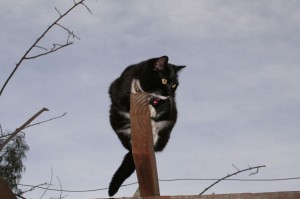
What do kidneys do?
The kidneys remove waste products from the blood stream, regulate fluid and electrolyte balance, maintain the acid-base balance of the body and remove toxins and drugs. They also help maintain blood pressure and stimulate blood cell production.
What happens when my cat’s kidneys fail?
Signs of kidney failure don’t appear until at least 70% of kidney function is lost. Chronic kidney failure is known as renal failure.
Kidney damage accumulates for years before we see any signs. Even then the early signs of kidney failure – increased thirst and urine production – are not easily recognised in our feline friends.
You may notice an increasingly wet litter tray if your cat is only indoors. However if you have other cats you may not pick up increased urine production in a single cat.
Cats often drink from multiple water sources making it difficult to recognise increased consumption.
Other signs of kidney failure such as weight loss and poor coat quality are often put down to normal ageing.
Often the first thing we see is a cat off her food, vomiting, depressed and dehydrated. The kidneys are already badly affected by this stage.
How do we diagnose kidney failure?
We diagnose and stage kidney failure with blood tests for the two waste products, urea and creatinine and a urine analysis to measure the kidneys ability to concentrate urine. We also check the urine for protein loss or a urinary tract infection.
Tests for other substances like potassium, phosphorus and calcium as well as blood cell counts help us decide on the best course of treatment.
Could it have been diagnosed earlier?
Because signs of kidney failure and rises in blood urea and creatinine are not evident until significant loss of kidney function has occurred early diagnosis is difficult. However, we strongly recommend at least annual blood and urine tests, as well as regular body weight checks. If urine concentrating ability is deteriorating or the creatinine is trending up we are able to slow down the progression of the disease with a special kidney protective diet. Any weight loss in a cat should be fully investigated.
What treatments are available?
After initial hospitalisation to treat dehydration and electrolyte disturbances, most cats are managed with a diet change and one or two other medications.
- Low protein and phosphorus diets lower the level of waste products in the bloodstream. Try a few of the ready made kidney diets like Royal Canin renal or Hills k/d to find one your cat likes. Once your cat accepts the diet it must be her sole source of nutrition. Although if renal failure is advanced and your cat’s appetite is poor, any diet that the cat enjoys is acceptable.
- If blood phosphorus levels remain above normal after a few weeks on the special diet we add phosphate binders like Ipakitine to the food. Reducing blood phosphorus makes your cat feel better and slows progression of the disease.
- Urinary tract infections are common in kidney failure and are treated with antibiotics.
- Cats with renal failure lose potassium in the urine leading to muscle weakness, stiffness, a poor coat and exacerbation of the kidney failure. The special kidney diets contain extra potassium but sometimes we have to add more.
- Severely affected cats need extra fluids. We can teach you to administer subcutaneous fluids at home to reduce dehydration in advanced cases.
FRESH WATER MUST BE AVAILABLE AT ALL TIMES
How long can I expect my cat to live?
Unfortunately aged kidneys do not recover. However, we can slow the progress of the disease and improve your cat’s well being with treatment and regular checkups. We check phosphorous and potassium levels to see if your cat requires supplements and check for urinary tract infections at least every 3 months. This should give your cat a good stretch of high quality, active life.
